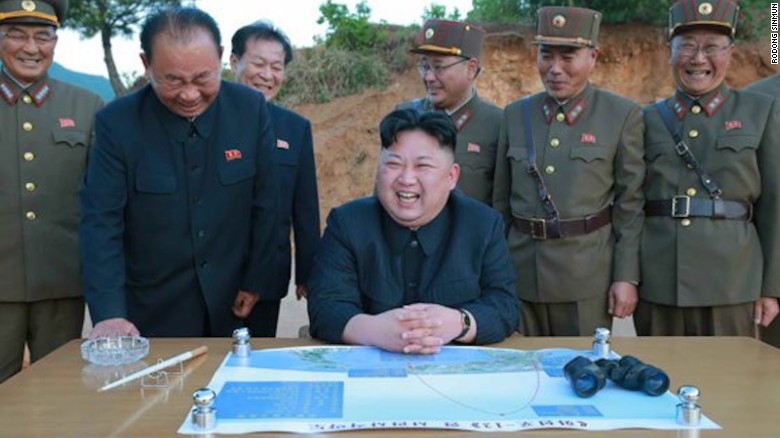North Korea conducted what has been referred to by experts as their “most successful” missile test to date on Sunday, demonstrating their ability to strike U.S. bases as far away as Guam with a hypothetically nuclear tipped missile.
Kim Jong Un is said to have personally supervised the launch of the Hwasong-12 missile, a never before tested iteration of North Korea’s ballistic missile program, and feasibly a significant stepping stone toward the development of a true Intercontinental Ballistic Missile capable of striking the mainland United States.
According to state-owned news outlet KCNA, Sunday’s test was “aimed at verifying the tactical and technological specifications of the newly developed ballistic rocket capable of carrying a large-size heavy nuclear warhead.”
KCNA went on to report that the Hwasong-12 reached a maximum altitude of 2,111.5 kilometers (or 1,312 miles) above the surface of the earth before re-entering the atmosphere and impacting a predesignated target 787 kilometers (489 miles) away.
“North Korea’s latest successful missile test represents a level of performance never before seen from a North Korean missile,” aerospace engineer John Schilling wrote for 38 North, published by the US Korea Institute at Johns Hopkins University.
David Wright, the co-director and a senior scientist at the Union of Concerned Scientists, specializes in ballistic missile proliferation, ballistic missile defense, and nuclear weapons policy. According to a statement he published on his site, if the information provided by the North Korean media is accurate (or even close), it may be indicative of a ballistic missile capable of reaching targets as far away as 4,500 kilometers, or 2,796 miles. According to his analysis, it isn’t the distance the missile covered that gives away its potential, but rather how long it took to arrive on target. According to Wright:
“A missile with a range of 1,000 km (620 miles), such as the extended-range Scud, or Scud-ER, would only have a flight time of about 12 minutes if flown on a slightly lofted trajectory that traveled 700 km.
A 30-minute flight time would instead require a missile that was highly lofted, reaching an apogee of about 2,000 km (1,240 miles) while splashing down at a range of 700 km. If that same missile was flown on a standard trajectory, it would have a maximum range of about 4,500 km (2,800 miles).”

Wright went on to postulate that the missile tested on Sunday may have been the same design seen paraded through Pyongyang during last month’s national celebration of the birth of Kim Jong Un’s grandfather, Kim Il Sung. At the time, it was widely speculated that the large, mobile missile platforms seen in the parade were actually fakes intended merely to convey the idea that North Korea possessed larger missiles than their tests have demonstrated thus far.
Of course, that distance, while significant, doesn’t truly make it a true ICBM. Instead, the Hwasong-12 serves as North Korea’s most powerful regional nuclear “deterrent,” as it can target a number of us U.S. installations overseas, including the U.S. Naval Base in Guam that sees regular rotations of some of America’s most advanced long-range bombers and serves as the home port of Naval Special Warfare Unit One, among others.
Already have an account? Sign In
Two ways to continue to read this article.
Subscribe
$1.99
every 4 weeks
- Unlimited access to all articles
- Support independent journalism
- Ad-free reading experience
Subscribe Now
Recurring Monthly. Cancel Anytime.
More pressing, is the suggestion that the Hwasong-12 could serve as a portion of a later, more advanced missile, as ICBMs are commonly built in two or three stages. This missile demonstrated the ability to reach the type of altitude required of a ICBM, all they would need to do is add an additional stage to carry the warhead further once it reached its maximum height.
North Korea would need to develop a missile capable of covering 3,400 kilometers in order to accurately strike Guam, which seems possible given their most recent test. However, they would need to nearly double that figure to 7,000 kilometers in order to strike Hawaii, and the closest possible targets on the American West Coast would require a range that exceeds 8,000 kilometers, still well beyond North Korea’s capabilities, even if this test places them further along on that hunt than earlier predictions.
Of course, any concern about a nuclear strike on any target relies on the idea that not only has Kim Jong Un’s regime attained the ability to build and detonate nuclear weapons (which we know to be a fact) but they must also have developed the technological capability to miniaturize the device into something mountable on a missile. Analysts have seen pictures released by the North Korean regime that indicate they may have successfully done so, but there has been no hard evidence to back up those suppositions.
Although there is no guarantee North Korea actually possesses the miniaturized warheads necessary to mount a nuclear offensive via ballistic missiles, Sunday’s test may have far-reaching implications in the way we must perceive the regular, and theatrical, statements made by Kim’s reclusive regime. It would seem he may not have been bluffing about being “close” to developing a missile capable of striking targets as far away as the United States, and even the missiles many in the West thought could be nothing but props now appear to have either been real, or at least based on real missiles housed elsewhere.
More than demonstrating their ability to launch missiles that are more advanced and capable than we once believed, this test may truly serve as a statement intended to take the wind out of the sails of any who think Kim’s nuclear ambitions are nothing more than empty posturing. As of Sunday, Kim Jong Un proved that not everything he says is baseless, and we may want to start listening a bit more closely.
Images courtesy of KCNA












COMMENTS
You must become a subscriber or login to view or post comments on this article.